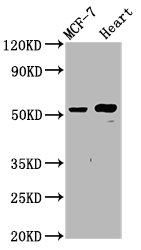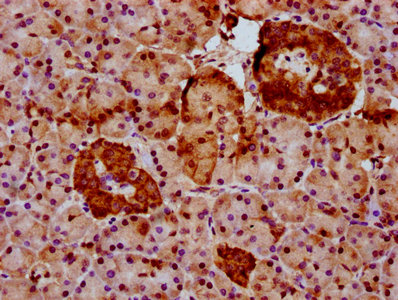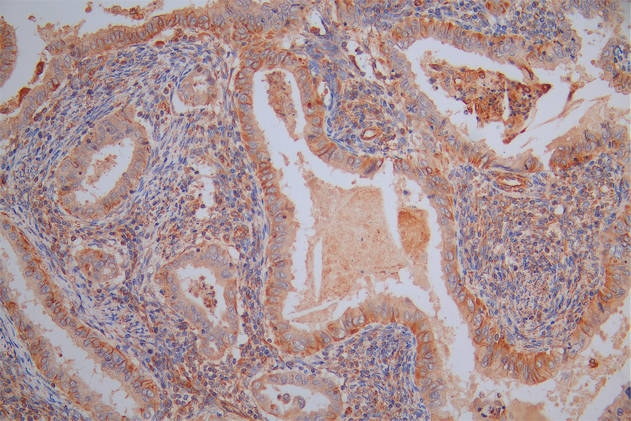NOP53 Antibody
-
中文名稱:NOP53兔多克隆抗體
-
貨號:CSB-PA885778LA01HU
-
規(guī)格:¥440
-
圖片:
-
Western Blot
Positive WB detected in: MCF-7 whole cell lysate, Rat heart tissue
All lanes: NOP53 antibody at 4.8μg/ml
Secondary
Goat polyclonal to rabbit IgG at 1/50000 dilution
Predicted band size: 55 kDa
Observed band size: 55 kDa -
IHC image of CSB-PA885778LA01HU diluted at 1:600 and staining in paraffin-embedded human pancreatic tissue performed on a Leica BondTM system. After dewaxing and hydration, antigen retrieval was mediated by high pressure in a citrate buffer (pH 6.0). Section was blocked with 10% normal goat serum 30min at RT. Then primary antibody (1% BSA) was incubated at 4°C overnight. The primary is detected by a biotinylated secondary antibody and visualized using an HRP conjugated SP system.
-
-
其他:
產(chǎn)品詳情
-
產(chǎn)品名稱:Rabbit anti-Homo sapiens (Human) NOP53 Polyclonal antibody
-
Uniprot No.:
-
基因名:NOP53
-
別名:Glioma tumor suppressor candidate region gene 2 protein antibody; GLTSCR2 antibody; GSCR2_HUMAN antibody; p60 antibody; PICT1 antibody; protein interacting with carboxyl terminus 1 antibody
-
宿主:Rabbit
-
反應種屬:Human, Rat
-
免疫原:Recombinant Human Ribosome biogenesis protein NOP53 protein (227-405AA)
-
免疫原種屬:Homo sapiens (Human)
-
標記方式:Non-conjugated
本頁面中的產(chǎn)品,NOP53 Antibody (CSB-PA885778LA01HU),的標記方式是Non-conjugated。對于NOP53 Antibody,我們還提供其他標記。見下表:
-
克隆類型:Polyclonal
-
抗體亞型:IgG
-
純化方式:>95%, Protein G purified
-
濃度:It differs from different batches. Please contact us to confirm it.
-
保存緩沖液:Preservative: 0.03% Proclin 300
Constituents: 50% Glycerol, 0.01M PBS, pH 7.4 -
產(chǎn)品提供形式:Liquid
-
應用范圍:ELISA, WB, IHC
-
推薦稀釋比:
Application Recommended Dilution WB 1:500-1:5000 IHC 1:500-1:1000 -
Protocols:
-
儲存條件:Upon receipt, store at -20°C or -80°C. Avoid repeated freeze.
-
貨期:Basically, we can dispatch the products out in 1-3 working days after receiving your orders. Delivery time maybe differs from different purchasing way or location, please kindly consult your local distributors for specific delivery time.
-
用途:For Research Use Only. Not for use in diagnostic or therapeutic procedures.
相關產(chǎn)品
靶點詳情
-
功能:Nucleolar protein which is involved in the integration of the 5S RNP into the ribosomal large subunit during ribosome biogenesis. In ribosome biogenesis, may also play a role in rRNA transcription. Also functions as a nucleolar sensor that regulates the activation of p53/TP53 in response to ribosome biogenesis perturbation, DNA damage and other stress conditions. DNA damage or perturbation of ribosome biogenesis disrupt the interaction between NOP53 and RPL11 allowing RPL11 transport to the nucleoplasm where it can inhibit MDM2 and allow p53/TP53 activation. It may also positively regulate the function of p53/TP53 in cell cycle arrest and apoptosis through direct interaction, preventing its MDM2-dependent ubiquitin-mediated proteasomal degradation. Originally identified as a tumor suppressor, it may also play a role in cell proliferation and apoptosis by positively regulating the stability of PTEN, thereby antagonizing the PI3K-AKT/PKB signaling pathway. May also inhibit cell proliferation and increase apoptosis through its interaction with NF2. May negatively regulate NPM1 by regulating its nucleoplasmic localization, oligomerization and ubiquitin-mediated proteasomal degradation. Thereby, may prevent NPM1 interaction with MYC and negatively regulate transcription mediated by the MYC-NPM1 complex. May also regulate cellular aerobic respiration. In the cellular response to viral infection, may play a role in the attenuation of interferon-beta through the inhibition of DDX58/RIG-1.
-
基因功能參考文獻:
- Blocking cytoplasmic translocation of nucleolar protein NOP53 by deleting its nuclear export sequence abrogated its support of viral replication. Recombinant N3-T protein, containing NOP53 residues 330-432 and a human immunodeficiency virus-derived cell-penetrating Tat peptide, attenuated the expression of IFN-beta; and IFN-stimulated genes, as well as decreased the phosphorylation of interferon regulatory factor3. PMID: 29677136
- The findings of this study suggest that disruption of PICT-1 protein expression and codon 389 polymorphism can contribute to the pathogenesis or neoplastic progression of endometrial cancer. PMID: 29617699
- The study presented evidence that viral infection induced translocation of GLTSCR2 from nucleus to cytoplasm, and cytoplasmic translocation enabled GLTSCR2 to effectively attenuate IFN-beta and support viral replication; however, viral infection did not result in elevating GLTSCR2 in cells. PMID: 27824081
- PICT-1 triggers pro-death autophagy through inhibition of rRNA transcription and the inactivation of AKT/mTOR/p70S6K pathway in glioblastoma cells. PMID: 27729611
- PICT-1 is a major nucleolar sensor of the DNA damage repair response and an important upstream regulator of p53 via the RPL11-MDM2-p53 pathway. PMID: 27829214
- Codon 389 polymorphism in PICT-1 is a risk factor for uterine cervical cancers.PICT-1 counteracts HPV-induced p53 degradation. PMID: 27996172
- GLTSCR2 is a crucially involved in the positive regulation of telomerase and chromosome stability. PMID: 27357325
- The expression of GLTSCR2 was suppressed in renal cell carcinomas, accentuating the malignant phenotype. PMID: 26724143
- GLTSCR2 is crucial for normal cellular function as well as for preventing the development or progression of cancer. The JNK-c-jun axis is indispensible for regulating the activities of GLTSCR2. PMID: 26903295
- GLTSCR2 was an upstream negative regulator of the nucleophosmin (NPM)-MYC axis involved in controlling the transcriptional activity of MYC. GLTSCR2 may be a candidate for suppressing the growth of cancer cells stimulated by MYC hyperactivation. PMID: 25956029
- Data show that tumor sppressor protein GLTSCR2 down-regulates total nucleophosmin (NPM) expression levels by decreasing its protein stability. PMID: 25818168
- We demonstrated the GLTSCR2 expression decreased with the rise of the grade of cervical lesions; GLTSCR2 may play an important role in carcinogenesis of cervical cancer PMID: 25118835
- These results suggest that PICT1 employs atypical proteasome-mediated degradation machinery to sense nucleolar stress within the nucleolus. PMID: 24923447
- High PICT1 expression is associated with hepatocellular carcinoma. PMID: 23532381
- GLTSCR2 is down-regulated in squamous cell carcinomas of the skin and UV light exposure decreases the stability of GLTSCR2 and sensitizes keratinocytes to DNA damage. PMID: 23942755
- Authors confirmed the interaction of PICT-1 with itself by direct yeast two-hybrid assay and also showed self-association of PICT-1 in mammalian cells by co-immunoprecipitation and fluorescence resonance energy transfer assays. PMID: 24735870
- GLTCR2 may play a role in the tumorigenesis, progression and biological behavior in breast cancer. PMID: 24054033
- GLTSCR2 controls cellular proliferation and metabolism via the transcription factor Myc, and is induced by mitochondrial stress, suggesting it may constitute a significant component of the mitochondrial signaling pathway. PMID: 24556985
- Findings suggest that PICT1 has a crucial role in gastric cancer progression by regulating the MDM2-TP53 pathway through RPL11. PMID: 24045667
- GLTSCR2 functions as a tumor suppressor in prostatic adenocarcinomas. PMID: 23920125
- The glioma tumor-suppressor candidate region gene 2 (GLTSCR2)is as a new member of the nucleolus-nucleoplasmic axis for p53 regulation. PMID: 22522597
- Repeated hypoxia downregulates p53-upstream regulator, GLTSCR2, which resulted in increased death resistance and invasive potential of glioblastoma cells. Restoration of GLTSCR2 expression suppressed the malignant potential of hypoxia-selected cells. PMID: 22850112
- PICT-1 exhibits a nucleolar distribution similar to proteins involved in ribosomal RNA processing, yet does not colocalize precisely with either UBF1 or Fibrillarin under normal or stressed conditions. PMID: 22292050
- GLTSCR2 seems to act as a tumor suppressor by participating in optimal DNA damage response because DNA damage is a frequent and crucial event in oncogenesis. PMID: 21741933
- PICT1 is a potent regulator of the MDM2-P53 pathway and promotes tumor progression by retaining RPL11 in the nucleolus. PMID: 21804542
- merlin mediates PICT-1-induced growth inhibition by translocating to the nucleolus and binding PICT-1 PMID: 21167305
- Our results show a down-regulation of GLTSCR2 in seborrheic keratosis, indicating that GLTSCR2 may have a protective effect on the development of SK. PMID: 20185249
- study describes a novel interaction between KS-Bcl-2 & PICT-1 cellular protein, encoded by a candidate tumor suppressor gene, GLTSCR2; show this interaction specifically targets KS-Bcl-2 to the nucleolus & decreases its antiapoptotic activity PMID: 20042497
- These results suggest that PICT-1 plays a role in phosphatidylinositol 3,4,5-trisphosphate signals through controlling PTEN protein stability. PMID: 16971513
- results suggest that the induction of PTEN-modulated apoptosis is one of the putative mechanisms of tumor suppressive activity by GLTSCR2 PMID: 17657248
- GLTSCR2 as a proapoptotic protein sensitizing cells to hypoxic injury when overexpressed PMID: 17890897
- GLTSCR2 expression is down-regulated in glioblastomas. Direct sequencing analysis and fluorescence in situ hybridization clearly demonstrates the presence of genetic alterations, such as a nonsense mutation and deletion, in the GLTSCR2 gene. PMID: 18729076
顯示更多
收起更多
-
亞細胞定位:Nucleus, nucleolus. Nucleus, nucleoplasm.
-
蛋白家族:NOP53 family
-
組織特異性:Expressed at high levels in heart and pancreas, moderate levels in placenta, liver, skeletal muscle, and kidney, and low levels in brain and lung.
-
數(shù)據(jù)庫鏈接:
Most popular with customers
-
YWHAB Recombinant Monoclonal Antibody
Applications: ELISA, WB, IHC, IF, FC
Species Reactivity: Human, Mouse, Rat
-
Phospho-YAP1 (S127) Recombinant Monoclonal Antibody
Applications: ELISA, WB, IHC
Species Reactivity: Human
-
-
-
-
-
-





















